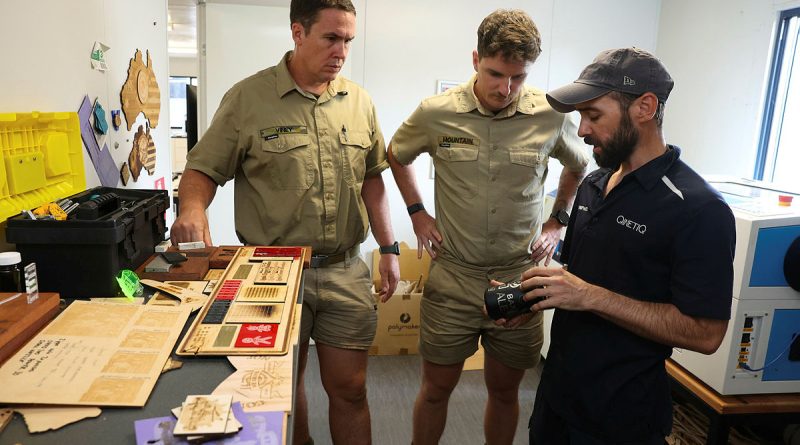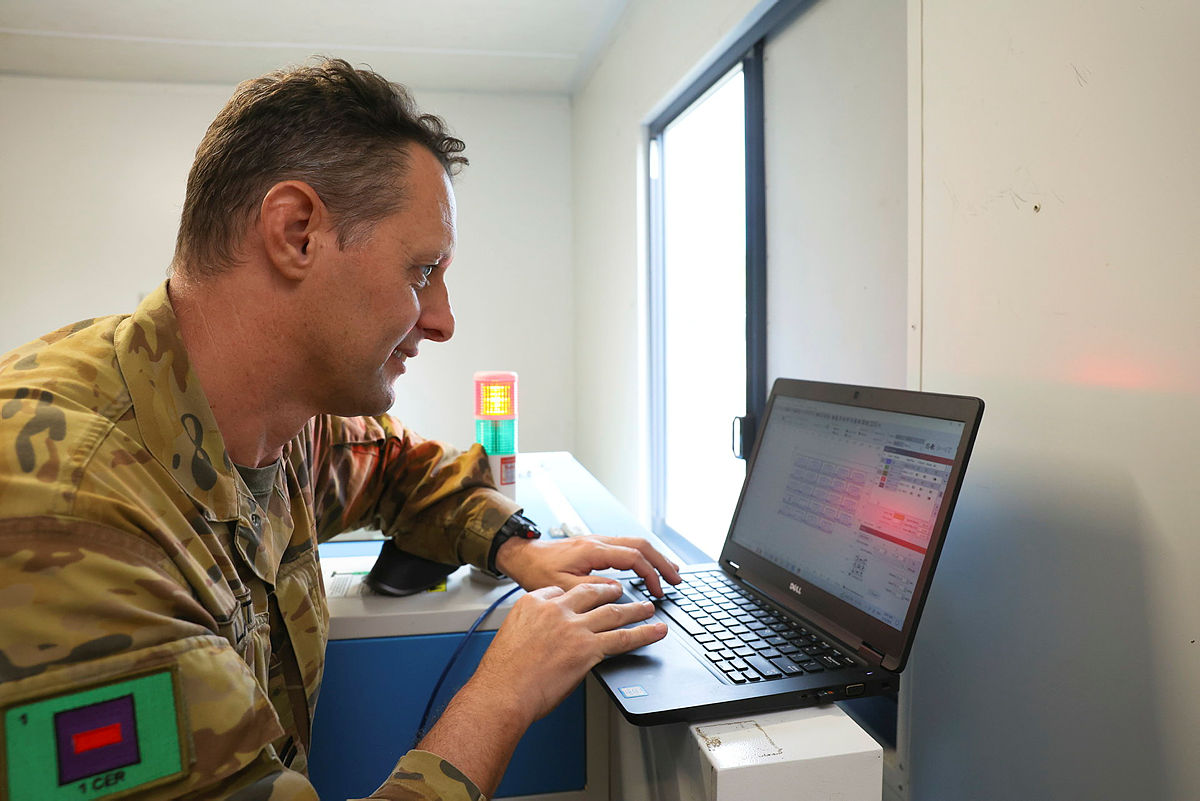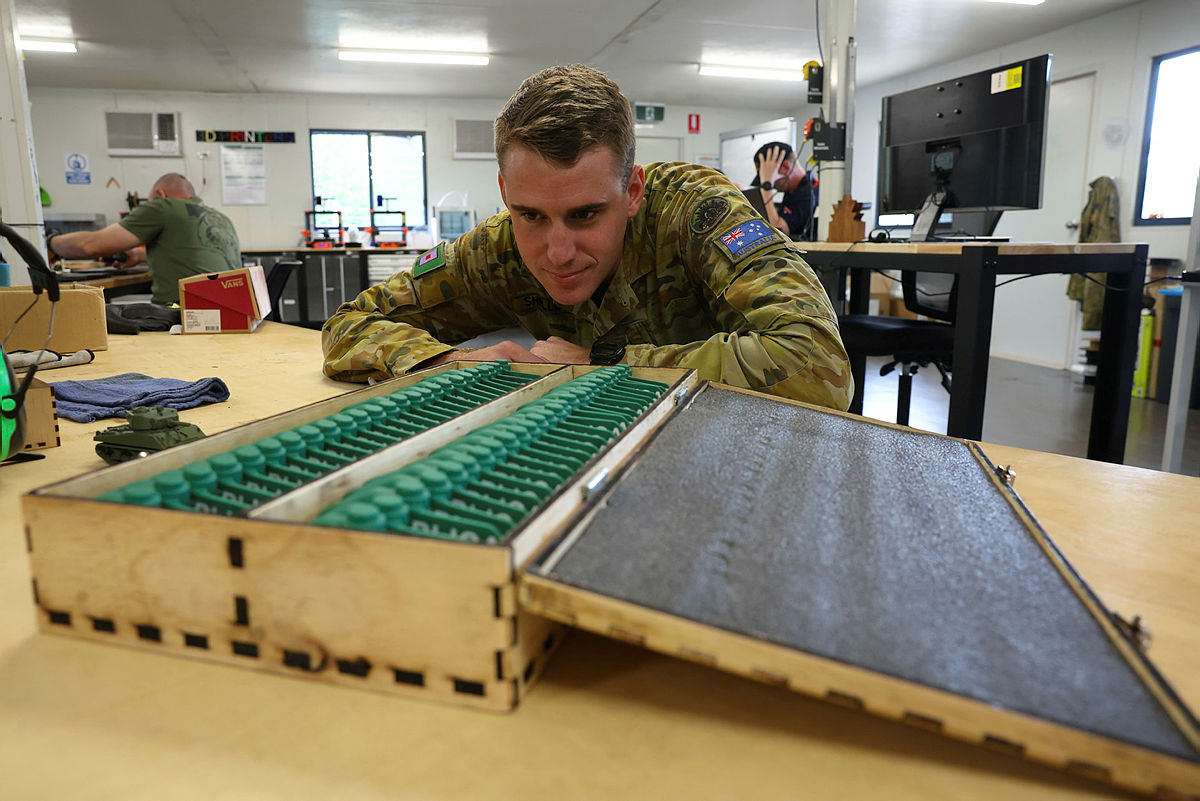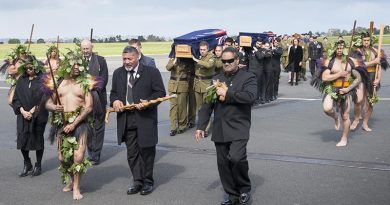MakerSpace solves big problems with clever ideas
Share the post "MakerSpace solves big problems with clever ideas"

Tucked away on Robertson Barracks lies a workshop that hums with creativity, problem-solving and quiet ingenuity.
CAPTION: MakerSpace site supervisor Daniel Deleur shows Craftsmen Edward Viney and Dylan Mountain things people have made, during a site induction at the MakerSpace on Robertson Barracks. Story and photos by Warrant Officer Class 2 Max Bree.
Since opening its doors in 2021, the MakerSpace has become Darwin’s hub where Defence personnel can tinker and innovate.
Whether it’s sewing longer flaps onto bush hats, designing aviation tool-kit holders, or 3D printing scale model landing craft for mud models, the space helps solve big problems with clever ideas.
About 100 personnel visit each week and can be guided by one of the site supervisors, Dan Deleur, a former Army fitter armourer who’s been working at MakerSpace for two-and-a-half years.
For Mr Deleur, his work isn’t just about what gets made – it’s about expanding minds.
“The space is 100 per cent about the brain,” he said.
“It’s about building your knowledge of what is possible, and how to make things. You gain experience, and as a bonus you get the gratification of making a physical item as well.”
While objects for personal use are encouraged, many aim to help make soldiers’ jobs easier by creating items ranging from pouches fashioned from old camouflage uniform pockets, to prototyping parts for night-vision goggles.
Mr Deleur believes that the MakerSpace program is offering an alternative approach to problems soldiers face.
“Instead of thinking, ‘This is broken, why isn’t it fixed?’ we are changing that outlook to, ‘How can I fix this? Is there something I can do?’,” he said.
CAPTION: Army Corporal Euan Lamont programs a laser cutter at the MakerSpace on Robertson Barracks.
Corporal Euan LaMont, of 1st Combat Engineer Regiment, knows how MakerSpace can streamline operations and improve efficiency.
Over the past 18 months, he’s taken ideas from concept to creation, beginning with learning the basics of laser cutting and 3D printing.
His latest project was developing magnetic markers for the regiment’s operations room map, an upgrade from the sticky flags previously used to track everything from sub units to sections.
He came up with the idea, prototyped various styles and colour combinations, then used the laser cutter to slice and etch a set of white acrylic markers with blue highlights.
CAPTION: Laser-cut acrylic pieces denoting different sub units, platoons and troops from the 1st Combat Engineer Regiment, produced at the Robertson Barracks MakerSpace. They were made to help the unit operations staff more easily track locations on their headquarters maps.
Corporal LaMont has also made farewell plaques and new signs, and next plans to design engineer-specific coins and a flipper for Anzac Day.
“These are little, one per cent things that make life a lot easier,” he said.
“There’s a lot of applications. When you’ve got these skills in place, it makes the time you have for training more effective and makes the atmosphere around the unit better.”
Beyond physical creations, MakerSpace also offers an outlet for mental wellbeing, as a rank-free zone where personnel can relax.
CAPTION: Army combat engineer Lance Corporal Doug Shellcot with the 3D-printed replica PFM-1 butterfly mines he produced at the Robertson Barracks MakerSpace.
“Makers don’t need to engage with us if they don’t want to,” Mr Deleur said.
“If they want to come here and paint models because that clears their head, go for it.
“When learning the processes, programs and skills, even 3D printing a Dungeons & Dragons model gets the same result as creating something the Army has requested, ultimately building cognition.
“It’s about taking an idea and combining the commitment and capability to guide it through to a physical object.”
Mr Deleur’s favourite tool is the laser cutter, as it can offer rapid prototyping and instant gratification.
“Once you know how, sketch to physical item can be as quick as 30 minutes, making this process a great first stepping stone,” he said.
“To commanders, I’d say: ‘You are also welcome at the MakerSpace. Get involved and embrace the capability’.
“If we don’t have the capability to adapt and innovate, we’ll get left behind.”
.
.

.
.
Share the post "MakerSpace solves big problems with clever ideas"









I really like this idea. There should be a lot more of these facilities right around Australia, if they’re not already there.